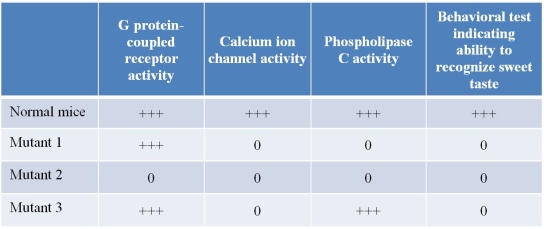Multiple Choice
Refer to the table below, which shows results from investigations of four mouse lineages.  Three of these lineages have different mutations that disrupt the signal transduction pathway that allows mice to recognize sweet taste in response to sugar.For each mouse group, each component of the signal transduction pathway was tested in terms of its response to sugar, which was provided as a stimulus of the pathway.In the table, "+++" refers to high levels of activity in the response to sugar, and "0" refers to no activity in the response to sugar.These results provide evidence for which role of calcium ion channels in this signal transduction pathway?
Three of these lineages have different mutations that disrupt the signal transduction pathway that allows mice to recognize sweet taste in response to sugar.For each mouse group, each component of the signal transduction pathway was tested in terms of its response to sugar, which was provided as a stimulus of the pathway.In the table, "+++" refers to high levels of activity in the response to sugar, and "0" refers to no activity in the response to sugar.These results provide evidence for which role of calcium ion channels in this signal transduction pathway?
A) Sugar binds to a receptor site on the exposed portion of the calcium ion channel protein, which initiates stimulation of the signal transduction pathway.
B) Activation of the G protein-coupled receptor transmits a signal to internal calcium ion channels, causing release of calcium ions that activate phospholipase C hydrolysis of PIP2.
C) Stimulation of the G protein-coupled receptor activates phospholipase C hydrolysis of PIP2 to release IP3, which activates internal calcium ion channels to release calcium ions.
D) Activation of phospholipase C transmits a signal to the G protein-coupled receptor, which activates internal calcium ion channels, causing release of calcium ions.
E) Sugar binds to a receptor site on the exposed portion of the phospholipase C protein, which initiates activation of the G protein-coupled receptor that then activates internal calcium ion channels, causing release of calcium ions.
Correct Answer:

Verified
Correct Answer:
Verified
Q194: Refer to the table below. <img src="https://d2lvgg3v3hfg70.cloudfront.net/TB5650/.jpg"
Q195: Refer to the table below, which lists
Q196: Receptors bind to their ligands noncovalently, according
Q197: Protein kinase receptors phosphorylate themselves and/or other
Q198: The second messenger cAMP can be effective
Q200: Refer to the figure below. <img src="https://d2lvgg3v3hfg70.cloudfront.net/TB5650/.jpg"
Q201: Which gives the correct order from lowest
Q202: In the signal cascade triggered by epinephrine
Q203: Which sequence lists signaling types in order
Q204: A researcher finds that mouse kidney cells